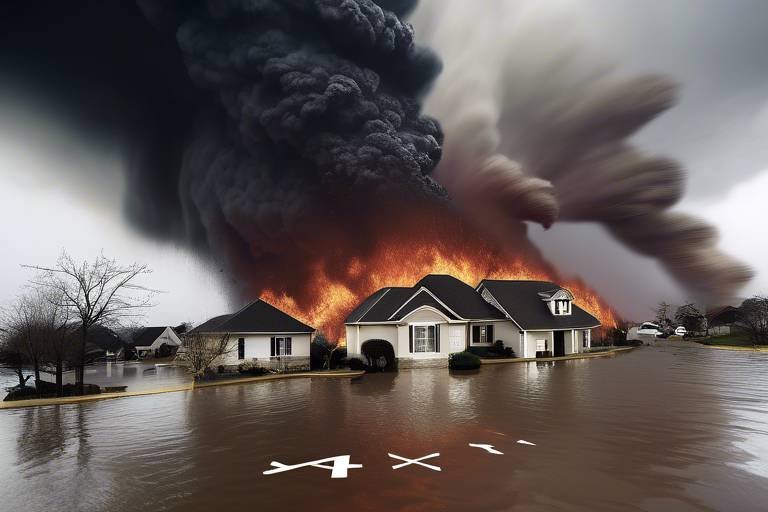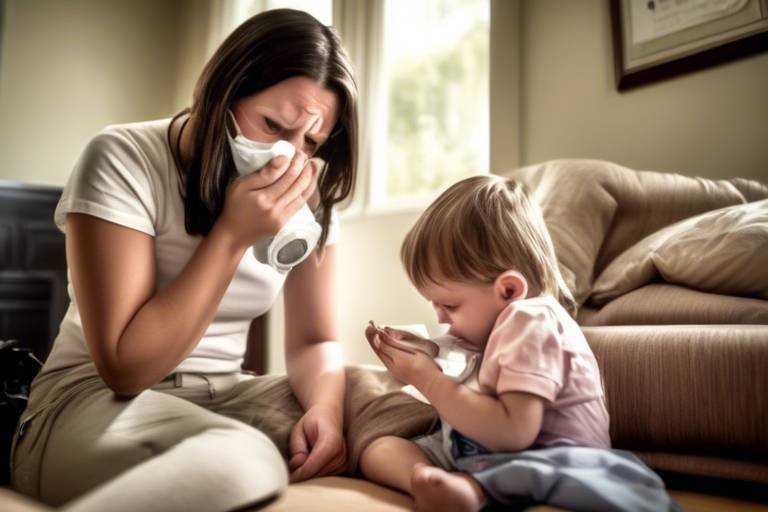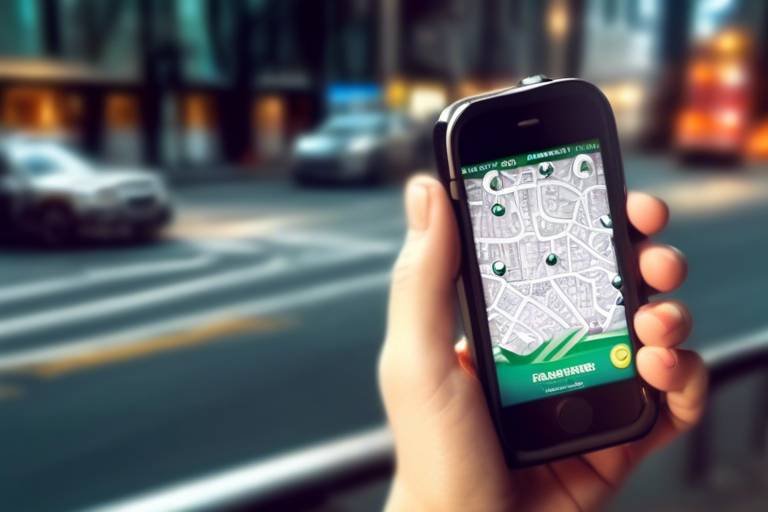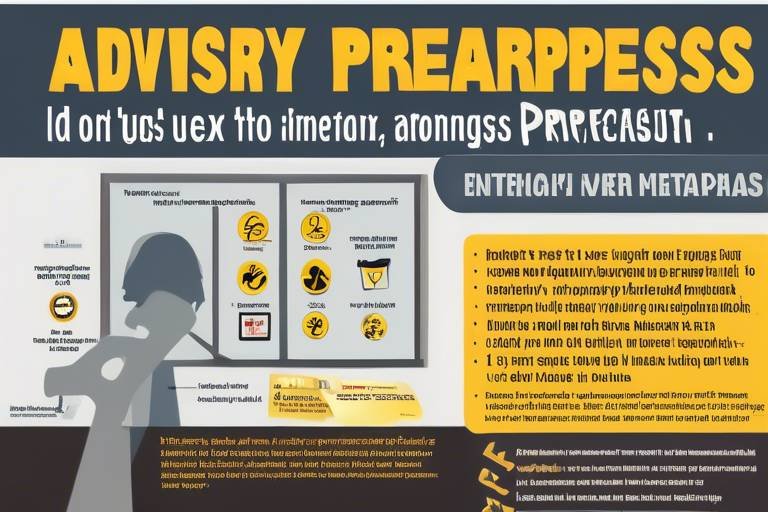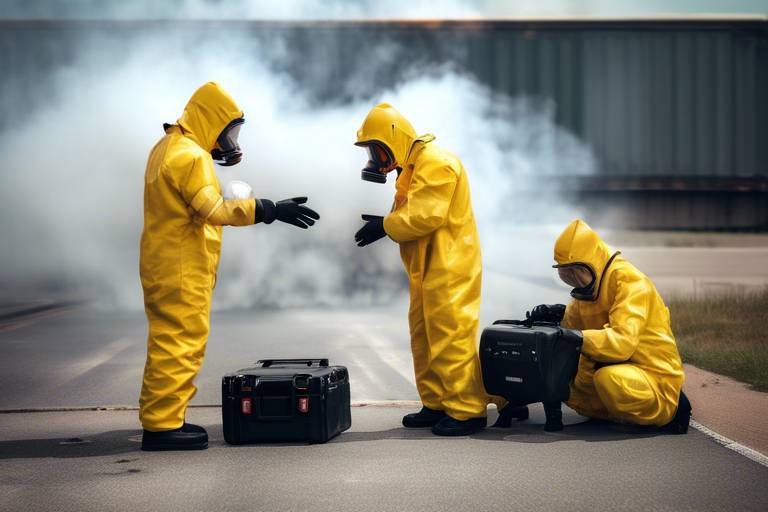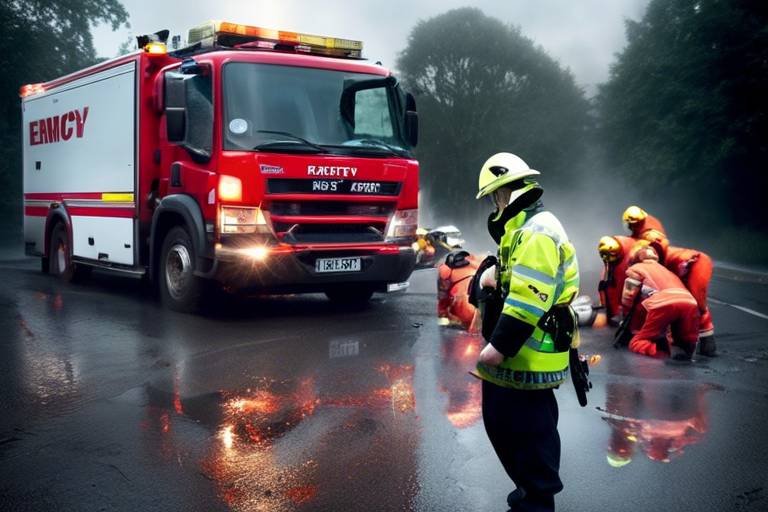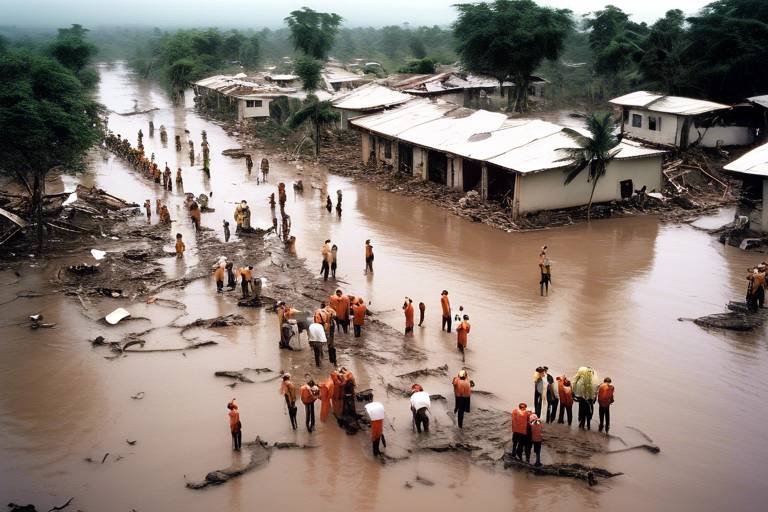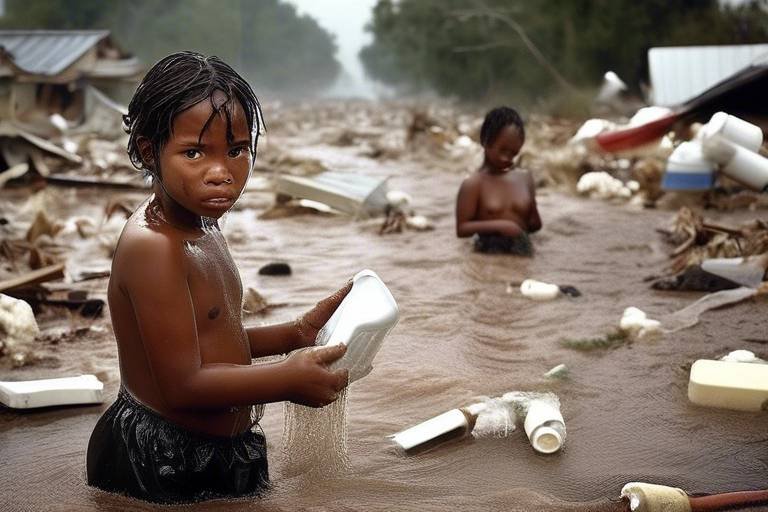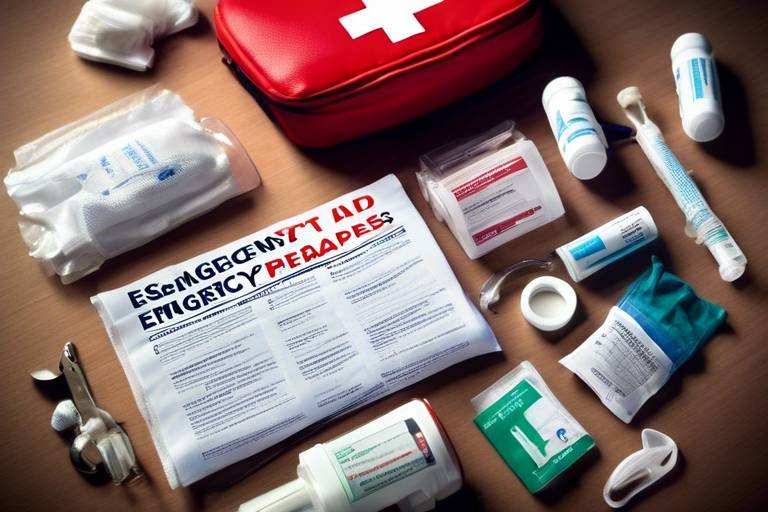Implementing Inclusivity in Disaster Preparedness and Response
In a world where natural disasters can strike without warning, the importance of inclusivity in disaster preparedness and response cannot be overstated. When we talk about inclusivity, we're not just throwing around a buzzword; we're addressing a fundamental principle that can make the difference between chaos and effective recovery. Imagine a community where every voice matters, where every individual—regardless of their background—has a seat at the table during the planning of disaster response strategies. This is not just a dream; it's a necessity for building resilient communities. By ensuring that marginalized groups, including the elderly, disabled, and economically disadvantaged, are actively involved in preparedness efforts, we can create a safety net that benefits everyone.
Inclusivity in disaster management isn't just about checking boxes or fulfilling legal obligations; it's about fostering trust and enhancing the overall resilience of a community. When people feel heard and valued, they are more likely to cooperate during emergencies, follow safety protocols, and assist one another. Think of it this way: a well-prepared community is like a well-oiled machine, where every cog and wheel plays a vital role in keeping everything running smoothly. Without inclusivity, we risk leaving vulnerable populations behind, which can lead to disastrous consequences when a crisis hits.
Moreover, embracing inclusivity can lead to innovative solutions that might not have been considered otherwise. Diverse perspectives can illuminate unique challenges and opportunities, allowing for a more comprehensive approach to disaster preparedness. For instance, what works for one group may not necessarily work for another, and understanding these nuances can significantly enhance the effectiveness of response strategies. In short, inclusivity is not merely beneficial; it's essential for effective disaster management.
As we delve deeper into this topic, we'll explore practical strategies for implementing inclusivity in disaster preparedness and response. We'll examine the barriers that exist, the importance of engaging community leaders, and how technology can be harnessed to identify and involve vulnerable populations. Together, these elements create a roadmap for a more inclusive approach to disaster management, ensuring that no one is left behind when the next crisis strikes.
Inclusivity in disaster preparedness ensures that all community members, especially marginalized groups, have a voice. This approach fosters equity, enhances trust, and improves overall community resilience during crises.
Recognizing vulnerable populations is essential for effective disaster response. This section discusses methods for identifying these groups, including age, disability, socioeconomic status, and cultural background, to ensure their needs are met.
Accurate data collection is crucial for understanding community demographics. This subsection examines various techniques for gathering data, including surveys, interviews, and community mapping.
Community leaders play a vital role in identifying vulnerable populations. This section highlights strategies for collaborating with them to gather insights and foster inclusivity in planning efforts.
Technology can enhance data collection and outreach efforts. This subsection explores tools like GIS mapping and social media to identify and engage vulnerable groups effectively.
Despite the benefits, several barriers hinder inclusivity in disaster preparedness. This section discusses challenges such as lack of resources, awareness, and communication barriers that must be addressed.
Implementing effective strategies is key to enhancing inclusivity in disaster preparedness. This section outlines practical approaches, including training, community engagement, and collaboration with diverse organizations.
Training programs for emergency responders can improve inclusivity. This subsection emphasizes the importance of cultural competency and sensitivity training to better serve diverse communities.
Engaging communities in the planning process fosters ownership and resilience. This section discusses how workshops, focus groups, and public forums can facilitate meaningful participation from all community members.
Evaluating the effectiveness of inclusivity initiatives is crucial for continuous improvement. This section outlines methods for assessing inclusivity in disaster preparedness and response efforts, ensuring accountability and effectiveness.
- Why is inclusivity important in disaster preparedness?
Inclusivity ensures that all community members, especially those from marginalized groups, can voice their needs and concerns, leading to more effective and equitable disaster response. - How can we identify vulnerable populations?
Vulnerable populations can be identified through various methods, including demographic surveys, community mapping, and collaboration with local leaders. - What are some barriers to inclusivity?
Barriers include lack of resources, insufficient awareness, and communication challenges that can prevent marginalized groups from participating in disaster preparedness efforts. - What strategies can enhance inclusivity?
Strategies include training emergency responders in cultural competency, engaging communities through workshops, and leveraging technology for outreach.

The Importance of Inclusivity
Inclusivity in disaster preparedness isn't just a nice-to-have; it's a critical necessity. Imagine a community facing a disaster where only some voices are heard—what happens to those left behind? When we prioritize inclusivity, we ensure that every community member, especially those from marginalized groups, has a say in the planning and response processes. This approach not only fosters equity but also builds trust among community members and emergency responders alike.
Think about it: when everyone feels included, they are more likely to participate actively, share vital information, and contribute to recovery efforts. This is particularly important during crises, where the stakes are high, and the need for accurate information is paramount. By integrating diverse perspectives, we can create solutions that are not only effective but also culturally sensitive and relevant. For instance, disaster plans that account for different languages, disabilities, and cultural practices are more likely to succeed.
Moreover, inclusivity enhances community resilience. Communities that embrace diversity in their disaster preparedness strategies tend to bounce back quicker. They are better equipped to handle challenges because they have drawn on a wider range of experiences and ideas. Involving various groups can lead to innovative approaches that traditional methods might overlook. This can include everything from tailored communication strategies to specific resource allocations that address the unique needs of different populations.
However, achieving inclusivity isn't without its challenges. It requires a commitment to understanding and addressing the barriers that often exclude certain groups. These can include language barriers, lack of access to information, and insufficient outreach efforts. By recognizing and actively working to dismantle these barriers, we can create a more inclusive environment where everyone feels valued and prepared.
In summary, the importance of inclusivity in disaster preparedness cannot be overstated. It is not just about ensuring that everyone has a voice; it's about building a stronger, more resilient community where all members can contribute to and benefit from disaster response efforts. As we move forward, let’s commit to making inclusivity a cornerstone of our disaster management strategies.

Identifying Vulnerable Populations
When it comes to disaster preparedness, one of the most critical steps is . These are the individuals and groups who may face greater challenges during a crisis, whether due to physical limitations, socioeconomic status, or cultural barriers. By recognizing these populations, we can tailor our strategies to ensure that their specific needs are met, ultimately enhancing community resilience.
So, who exactly are these vulnerable populations? They can include a variety of groups, such as:
- The Elderly: Older adults may have mobility issues or health conditions that make them more susceptible during disasters.
- People with Disabilities: This group often requires specialized assistance and resources during emergencies.
- Low-Income Families: Economic constraints can limit access to necessary resources like transportation, food, and shelter.
- Cultural Minorities: Language barriers and different cultural practices can hinder effective communication and access to services.
Understanding the unique characteristics and challenges faced by these groups is essential for effective disaster response. For instance, the elderly may need more time to evacuate, while individuals with disabilities might require specific accommodations. Therefore, the question arises: how do we go about identifying these populations in our communities?
One effective method is through comprehensive data collection. Gathering accurate demographic data helps us understand who lives in our communities and what their needs are. This can be accomplished using various techniques, including:
| Data Collection Method | Description |
|---|---|
| Surveys | Conducting surveys can provide valuable insights into the demographics and needs of community members. |
| Interviews | One-on-one interviews can yield in-depth information about individual experiences and challenges. |
| Community Mapping | Mapping community resources and demographics visually can help identify gaps and areas of need. |
In addition to data collection, engaging with community leaders is another vital strategy. These leaders often have deep connections within their communities and can provide insights into the needs of vulnerable populations. By collaborating with them, we can gather valuable information that may not be captured through traditional data collection methods.
Furthermore, leveraging technology can significantly enhance our ability to identify and engage these groups. Tools like Geographic Information Systems (GIS) mapping can help visualize data and pinpoint areas with high concentrations of vulnerable populations. Social media platforms can also serve as channels for outreach, allowing us to disseminate information quickly and effectively.
In summary, identifying vulnerable populations is a multifaceted process that requires a combination of data collection, community engagement, and the use of technology. By taking these steps, we can ensure that all community members are included in disaster preparedness and response efforts, paving the way for a more resilient future.

Data Collection Methods
Accurate data collection is the bedrock of effective disaster preparedness and response. Without a clear understanding of community demographics, we risk overlooking the needs of vulnerable populations. Imagine trying to navigate a ship through foggy waters without a map; that’s what it feels like when we lack proper data. There are several methods we can employ to gather this crucial information.
One of the most common techniques is through surveys. Surveys can be distributed both online and offline, allowing us to reach a broader audience. They should be designed to capture essential details such as age, disability status, socioeconomic background, and cultural preferences. The beauty of surveys lies in their versatility; they can be tailored to suit different communities, ensuring that the questions resonate with the respondents.
Another effective method is conducting interviews. These one-on-one conversations can provide deeper insights into the experiences and needs of individuals, particularly those from marginalized groups. Through interviews, we can ask open-ended questions that allow respondents to share their stories, challenges, and suggestions for improvement. This not only enriches our data but also fosters a sense of trust and inclusivity within the community.
Community mapping is yet another innovative approach to data collection. This technique involves working with community members to visually represent resources, hazards, and vulnerable populations within their area. By mapping out these elements, we can identify gaps in preparedness and areas that require immediate attention. Community mapping is not just about collecting data; it also empowers individuals by involving them in the process, making them active participants in their own safety.
Moreover, we cannot overlook the role of technology in enhancing our data collection efforts. Tools such as Geographic Information Systems (GIS) allow us to analyze spatial data and visualize the distribution of resources and risks. Social media platforms also serve as valuable tools for engagement, enabling us to reach out to a wider audience and gather real-time feedback. By leveraging technology, we can streamline our data collection processes and make informed decisions that benefit everyone.
In conclusion, employing a mix of surveys, interviews, community mapping, and technology can significantly enhance our understanding of community demographics. The goal is not just to collect data but to create a comprehensive picture that reflects the needs and voices of all community members. After all, effective disaster preparedness is about ensuring that no one is left behind.

Engaging Community Leaders
Engaging community leaders is a pivotal step in fostering inclusivity within disaster preparedness and response efforts. These leaders are often the heartbeat of their communities, possessing invaluable insights into the unique needs and challenges faced by various groups. By collaborating with them, we can ensure that the voices of all community members, especially those from marginalized backgrounds, are heard and prioritized. After all, who better to guide us than those who understand the local context intimately?
To effectively engage community leaders, it’s essential to build genuine relationships based on trust and mutual respect. This involves more than just a one-time meeting; it requires ongoing dialogue and collaboration. Here are a few strategies that can help:
- Regular Meetings: Organizing consistent gatherings allows community leaders to share their experiences and concerns, fostering a sense of belonging and partnership.
- Inclusive Representation: Ensure that the leaders you engage represent a diverse cross-section of the community, including different ages, ethnicities, and socioeconomic backgrounds.
- Feedback Mechanisms: Establishing channels for community leaders to provide feedback on disaster plans not only empowers them but also enhances the overall effectiveness of those plans.
Additionally, it's crucial to recognize the unique skills that community leaders bring to the table. Many of them have experience in crisis management, local governance, or social services, which can be invaluable during disaster planning. By leveraging their expertise, we can create more robust and responsive preparedness strategies. For instance, community leaders can help identify local resources, such as shelters or food banks, that may not be widely known, ensuring that these resources are integrated into disaster response plans.
Moreover, engaging community leaders can also facilitate outreach to vulnerable populations. They often have established networks and can help disseminate information effectively, ensuring that everyone in the community is aware of the available resources and preparedness measures. This grassroots approach not only enhances communication but also builds trust within the community, making individuals more likely to participate in preparedness initiatives.
In conclusion, engaging community leaders is not just about gathering information; it’s about fostering a collaborative environment where all voices are valued. By prioritizing inclusivity in our engagement efforts, we can enhance community resilience and ensure that disaster preparedness and response plans are truly reflective of the needs of all community members.
- Why is engaging community leaders important in disaster preparedness? Engaging community leaders helps ensure that diverse voices are heard, which leads to more effective and inclusive disaster response strategies.
- How can we identify the right community leaders to engage? Look for leaders who are active in their communities, represent diverse groups, and have a strong understanding of local issues.
- What are some effective ways to build trust with community leaders? Consistent communication, transparency in decision-making, and showing genuine respect for their insights are key to building trust.

Utilizing Technology
In today's digital age, leveraging technology is not just a luxury; it's a necessity, especially when it comes to enhancing inclusivity in disaster preparedness and response. Imagine a world where every voice is heard, regardless of location or ability. Technology can turn this vision into reality by bridging gaps and ensuring that vulnerable populations are not left behind during crises. From Geographic Information Systems (GIS) mapping to social media platforms, the tools available to us are both diverse and powerful.
GIS mapping, for instance, allows emergency planners to visualize data in ways that highlight the needs of specific communities. By layering demographic information with geographical data, responders can identify areas with high concentrations of vulnerable populations, such as the elderly or those with disabilities. This visual representation can be crucial for effective resource allocation and targeted outreach efforts. Moreover, it helps in understanding the unique challenges each community may face during a disaster.
Social media is another game-changer. Platforms like Twitter and Facebook can be utilized to disseminate vital information quickly and efficiently. They serve as channels for real-time communication, enabling communities to share their needs and concerns. For instance, during a natural disaster, local authorities can post updates about evacuation routes, shelter locations, and safety tips. Additionally, these platforms allow for two-way communication, where community members can voice their experiences and challenges, thus fostering a sense of belonging and inclusivity.
However, it's important to recognize that not everyone has equal access to technology. This is where community engagement comes into play. By working with local leaders and organizations, we can ensure that technology is used in a way that reaches everyone. For example, setting up community centers with internet access or organizing workshops that teach digital literacy can empower marginalized groups. The goal is to create an ecosystem where technology serves as a bridge rather than a barrier.
Moreover, integrating technology into disaster preparedness requires ongoing training for both responders and community members. Emergency personnel need to be equipped with the skills to use these tools effectively, while community members should feel comfortable navigating technology to access information and resources. This mutual understanding can significantly enhance the overall effectiveness of disaster response efforts.
In summary, utilizing technology in disaster preparedness is not just about having the latest gadgets or software; it's about creating an inclusive environment where every individual has the opportunity to participate and be heard. By combining advanced tools with community engagement and training, we can forge a path toward a more resilient future, one that ensures no one is left behind when disaster strikes.

Barriers to Inclusivity
Inclusivity in disaster preparedness is not just a noble goal; it’s a necessity for effective response and recovery. However, achieving this inclusivity is often met with several barriers that can impede progress. One of the most significant challenges is the lack of resources. Many communities, particularly those that are marginalized or underfunded, struggle to allocate the necessary funds for inclusive planning and training. Without adequate resources, it becomes nearly impossible to implement effective programs that address the needs of all community members.
Another barrier is the awareness gap. Many individuals and organizations may not fully understand the importance of inclusivity in disaster management. This lack of awareness can lead to neglecting the unique needs of vulnerable populations, such as the elderly, disabled, or those from diverse cultural backgrounds. It’s essential to educate stakeholders about the benefits of inclusivity, as it enhances community resilience and ensures that everyone has a voice in the planning process.
Communication barriers also play a significant role in hindering inclusivity. In many cases, emergency management agencies fail to communicate effectively with all community members, particularly those who may not speak the dominant language or who have different communication needs. This disconnect can result in critical information not reaching those who need it most, leaving vulnerable populations unprepared and at greater risk during disasters.
Furthermore, there is often a lack of representation in decision-making processes. When the voices of marginalized groups are not included, their specific needs and perspectives are overlooked. This can lead to plans that do not adequately address the realities faced by these populations, ultimately compromising the effectiveness of disaster response efforts. It’s crucial to actively seek out and include diverse voices in all stages of disaster planning.
In summary, overcoming these barriers requires a concerted effort from all stakeholders involved in disaster management. By recognizing the challenges of resource allocation, awareness, communication, and representation, we can work towards a more inclusive approach that ensures all community members are prepared and supported during crises.
- What are the key barriers to inclusivity in disaster preparedness?
Key barriers include lack of resources, awareness gaps, communication barriers, and lack of representation in decision-making. - How can communities overcome these barriers?
Communities can overcome barriers by increasing funding, raising awareness, improving communication strategies, and ensuring diverse representation in planning processes. - Why is inclusivity important in disaster management?
Inclusivity ensures that all community members, especially vulnerable populations, have their needs met, which enhances overall community resilience and effectiveness during disasters.

Strategies for Inclusive Preparedness
When it comes to disaster preparedness, simply having a plan isn’t enough; we need to ensure that everyone, especially the most vulnerable, is included in that plan. This is where come into play. Think of it like building a house: if you don’t lay a solid foundation that considers everyone’s needs, the structure will be weak and may crumble in times of crisis. So, how can we ensure that our disaster preparedness efforts are truly inclusive?
First and foremost, training and capacity building are essential. Emergency responders must be equipped with the knowledge and skills to serve diverse communities effectively. This means not only understanding the technical aspects of disaster response but also being culturally competent. Imagine a firefighter who understands the unique needs of a community that speaks a different language; they can communicate better, build trust, and ultimately save lives. Training programs should include:
- Cultural competency: Understanding the cultural backgrounds of community members.
- Communication skills: Learning how to convey critical information in a way that is accessible to everyone.
- First aid and support training: Tailoring response strategies to meet the needs of specific groups, such as the elderly or people with disabilities.
Next, engaging communities through community engagement initiatives is vital. This means inviting community members to participate in the planning process rather than dictating terms from above. When people feel they have a stake in the process, they’re more likely to contribute. Workshops, focus groups, and public forums can serve as platforms for open dialogue, allowing residents to voice their concerns and preferences. Think of these gatherings as community brainstorming sessions; everyone brings their unique perspective, and together, they can forge a more comprehensive disaster preparedness plan.
Additionally, collaboration with diverse organizations can amplify these efforts. By partnering with local nonprofits, faith-based organizations, and advocacy groups, we can tap into existing networks that already support marginalized communities. These organizations often have established trust and communication channels, making it easier to disseminate information and gather feedback. It’s like having a well-oiled machine where each part works in harmony to achieve a common goal—ensuring that no one is left behind when disaster strikes.
Lastly, the role of technology in enhancing inclusivity cannot be overstated. Utilizing tools like GIS mapping and social media can help identify and engage vulnerable groups effectively. For example, GIS mapping can visually represent areas of high vulnerability, allowing planners to allocate resources more efficiently. Social media platforms can be used to disseminate information quickly and gather insights from community members in real-time. Imagine sending out a tweet or a Facebook post that reaches thousands, informing them about emergency services available in their area—it’s like casting a wide net to ensure everyone is informed and prepared.
In conclusion, implementing strategies for inclusive preparedness is not just a good practice—it’s a necessity. By focusing on training, engaging communities, collaborating with organizations, and leveraging technology, we can create a disaster preparedness framework that is equitable and effective. After all, in a world where disasters can strike at any moment, the strength of our response lies in our ability to come together as a community, ensuring that everyone’s voice is heard and valued.
Q: Why is inclusivity important in disaster preparedness?
A: Inclusivity ensures that all community members, especially marginalized groups, have a voice in disaster planning, which fosters equity and enhances overall community resilience.
Q: How can we identify vulnerable populations?
A: Vulnerable populations can be identified through data collection methods such as surveys, interviews, and community mapping, focusing on factors like age, disability, and socioeconomic status.
Q: What role do community leaders play?
A: Community leaders help identify vulnerable populations and can provide valuable insights into the specific needs of their communities, fostering inclusivity in planning efforts.
Q: How can technology assist in inclusive preparedness?
A: Technology, such as GIS mapping and social media, can enhance data collection and outreach, allowing for better identification and engagement of vulnerable groups.

Training and Capacity Building
Training and capacity building are essential components in fostering inclusivity within disaster preparedness and response. When emergency responders are equipped with the right skills and knowledge, they can effectively meet the diverse needs of their communities. This training goes beyond just understanding the technical aspects of disaster management; it also includes developing cultural competency and sensitivity. By embracing the unique backgrounds and experiences of various community members, responders can build trust and rapport, which are crucial during emergencies.
One of the most effective ways to enhance inclusivity is through comprehensive training programs tailored specifically for emergency personnel. These programs should cover various topics, including:
- Cultural Awareness: Understanding the cultural dynamics that may influence how individuals respond to disasters.
- Communication Skills: Learning to communicate effectively with diverse populations, including those with language barriers.
- Needs Assessment: Techniques for identifying and addressing the specific needs of marginalized groups.
Moreover, capacity building isn't just limited to formal training sessions. It can also involve engaging community members in the training process. For example, local leaders or representatives from marginalized groups can provide valuable insights and share their experiences, which can help shape training content. This collaborative approach not only enriches the training but also empowers community members, making them feel valued and heard.
To illustrate the impact of effective training and capacity building, consider the following table that outlines the potential benefits:
| Benefit | Description |
|---|---|
| Improved Response Time | Trained responders can act swiftly and efficiently, reducing the impact of disasters. |
| Enhanced Trust | When communities see trained responders who understand their needs, trust is built, facilitating better cooperation. |
| Increased Resilience | Communities that are involved in training are more likely to be prepared and resilient in the face of disasters. |
In conclusion, investing in training and capacity building is not just an option; it is a necessity for achieving true inclusivity in disaster preparedness and response. By equipping responders with the right tools and knowledge, we can ensure that all voices are heard and that every community member has the support they need during crises.
- Why is training important for inclusivity in disaster response? Training helps responders understand and address the unique needs of diverse populations, fostering trust and effective communication.
- What types of training should be included? Training should cover cultural awareness, communication skills, and needs assessment to ensure responders are well-prepared.
- How can community members get involved in training initiatives? Community members can participate by sharing their experiences and insights, which can help shape the training content.

Community Engagement Initiatives
Engaging communities in disaster preparedness is not just a good idea; it's a necessity. Think of it like building a sturdy house—without a solid foundation, everything else crumbles. Community engagement initiatives serve as that foundation, allowing residents to voice their concerns, share their experiences, and contribute to the planning process. When communities are actively involved, it fosters a sense of ownership and responsibility that can make a significant difference in the effectiveness of disaster response efforts.
One of the most effective ways to engage communities is through workshops and focus groups. These gatherings provide a platform for individuals to discuss their unique needs and challenges. Imagine a room filled with diverse voices—each person sharing their story, their fears, and their ideas. This exchange of information can lead to innovative solutions that traditional planning methods might overlook. It's like a potluck dinner where everyone brings their favorite dish; the more diverse the contributions, the richer the experience.
Public forums also play a crucial role in community engagement. They allow for open discussions where residents can ask questions, express concerns, and offer suggestions. This two-way communication not only builds trust between community members and disaster management authorities but also ensures that the plans developed are truly reflective of the community's needs. Think of it as a team huddle before a big game—everyone needs to know the strategy and feel included to play their part effectively.
Moreover, leveraging technology can enhance these engagement initiatives. Online platforms and social media can widen participation, especially for those who may have mobility issues or other barriers to attending in-person events. Virtual town halls or discussion boards can be incredibly effective, allowing for real-time feedback and interaction. This approach is akin to having a megaphone that amplifies the voices of those who might otherwise remain unheard.
To summarize, the key components of successful community engagement initiatives include:
- Workshops and Focus Groups: Facilitate in-depth discussions and gather diverse perspectives.
- Public Forums: Encourage open dialogue and build trust.
- Technology Utilization: Expand reach and accessibility through online platforms.
Ultimately, the goal of these initiatives is to create a collaborative environment where everyone feels empowered to contribute to disaster preparedness. By embracing inclusivity and actively engaging with community members, we can develop more effective strategies that not only respond to disasters but also build resilience within our communities. After all, when we work together, we can weather any storm.
Q1: Why is community engagement important in disaster preparedness?
Community engagement is crucial because it ensures that the voices of all community members, especially marginalized groups, are heard and considered in planning efforts. This leads to more effective and inclusive disaster response strategies.
Q2: How can technology be used for community engagement?
Technology can enhance community engagement through online platforms, social media, and virtual meetings, allowing for broader participation and real-time feedback from community members.
Q3: What are some challenges in engaging communities?
Challenges may include lack of awareness, limited resources, and communication barriers. Addressing these issues is vital for fostering effective engagement.

Evaluating Inclusivity Efforts
Evaluating the effectiveness of inclusivity initiatives is crucial for continuous improvement in disaster preparedness and response. It's not just about putting plans on paper; it's about ensuring those plans work for everyone, especially the most vulnerable. So, how do we go about this evaluation? Well, there are several methods that can help us assess whether our efforts are truly inclusive and effective.
First off, data collection plays a pivotal role in evaluation. Gathering feedback from community members can provide insights into how well inclusivity measures are being implemented. Surveys and interviews can be powerful tools here. Imagine conducting a survey that asks community members about their experiences during a disaster response. What worked? What didn’t? This kind of feedback can be gold for refining future efforts.
Another important aspect is engaging with community leaders and organizations that represent marginalized groups. These individuals often have a unique perspective on the needs of their communities and can provide valuable feedback on whether inclusivity strategies are effective. Regular check-ins with these leaders can help maintain a dialogue and ensure that the voices of all community members are heard.
Additionally, we should consider establishing clear metrics for success. What does inclusivity look like in our community? Is it the number of diverse voices in planning meetings? Or perhaps the accessibility of resources for all community members? By setting measurable goals, we can track our progress over time. For instance, we could create a table that outlines these metrics, making it easier to visualize our achievements and areas for improvement:
| Inclusivity Metric | Current Status | Target Status |
|---|---|---|
| Percentage of diverse community representation in planning meetings | 30% | 50% |
| Number of accessible resources available for disabled individuals | 5 | 10 |
| Community satisfaction score regarding inclusivity | 65% | 85% |
Moreover, it’s essential to create a feedback loop. After implementing changes based on evaluations, it’s important to go back to the community to see if those changes had the desired effect. This could be done through follow-up surveys or community forums where individuals can discuss their experiences with the new measures. Think of it as a cycle of learning and improvement: assess, implement, evaluate, and repeat.
Lastly, we should not underestimate the power of storytelling. Sharing success stories and challenges faced during the inclusivity efforts can inspire others and highlight the importance of continuous evaluation. These narratives can also serve as a reminder that inclusivity is not a one-time effort but a journey that requires ongoing commitment and engagement.
- Why is evaluating inclusivity efforts important? It helps to ensure that disaster preparedness and response strategies are effective for all community members, especially marginalized groups.
- What methods can be used for evaluation? Surveys, interviews, community feedback sessions, and established metrics are all effective methods for evaluating inclusivity.
- How can community leaders contribute to the evaluation process? Community leaders can provide insights and feedback on the needs and experiences of marginalized groups, helping to shape more effective inclusivity strategies.
- What role does storytelling play in evaluating inclusivity? Sharing stories can highlight successes and challenges, inspire others, and reinforce the importance of continuous evaluation and improvement.
Frequently Asked Questions
- What is the importance of inclusivity in disaster preparedness?
Inclusivity in disaster preparedness is crucial because it ensures that all members of a community, especially marginalized groups, have a voice in the planning and response processes. This approach fosters equity, enhances trust, and ultimately improves the resilience of the community during crises.
- How can we identify vulnerable populations in our community?
Identifying vulnerable populations can be achieved through various methods, including demographic data analysis, surveys, and community mapping. Key factors to consider include age, disability, socioeconomic status, and cultural background, ensuring that the needs of these groups are effectively met.
- What role do community leaders play in promoting inclusivity?
Community leaders are instrumental in promoting inclusivity as they possess local knowledge and can help identify vulnerable populations. Collaborating with these leaders can provide valuable insights and foster a more inclusive approach in disaster preparedness and response planning.
- What technological tools can enhance data collection for inclusive disaster planning?
Technological tools like Geographic Information Systems (GIS) mapping and social media platforms can significantly enhance data collection and outreach efforts. These tools allow for better identification and engagement of vulnerable groups, making the planning process more inclusive and effective.
- What are some common barriers to inclusivity in disaster preparedness?
Common barriers to inclusivity include a lack of resources, insufficient awareness about the needs of diverse populations, and communication challenges. Addressing these barriers is essential to ensure that all community members can participate in disaster preparedness efforts.
- How can training improve inclusivity among emergency responders?
Training programs focused on cultural competency and sensitivity can significantly improve inclusivity among emergency responders. By equipping responders with the skills to understand and respect diverse community needs, the overall effectiveness of disaster response can be enhanced.
- What methods can be used to evaluate inclusivity efforts in disaster management?
Evaluating inclusivity efforts can be done through various methods, such as surveys, feedback from community members, and performance metrics. These evaluations are crucial for continuous improvement and ensuring that inclusivity initiatives are effective and accountable.





